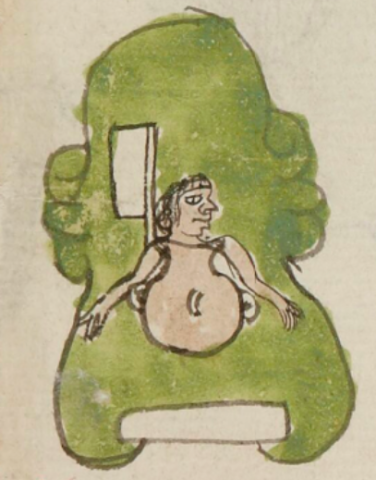Tlacaxopantepec (TR26r)
This compound glyph for the place name Tlacaxopantepec features several elements. One is a person (tlacatl), in this case a man (given the hairstyle) with his head in profile, looking toward the viewer's right, while his body is facing forward, with his two arms both visible. Part of a white cape (a garment a man would wear) might also be visible, but his body is otherwise obscured behind a large ceramic pot, usually called a comitl (although it does not play a phonetic role in the place name). Over the man's right shoulder--on the viewer's left--is an upright, white, rectangular flag, called a (panitl]), which does have a phonetic role in the compound glyph. The -tepec part of the place name is covered with the presence of the hill or mountain (tepetl), which is a tall, green, bell-shaped sign with curling rocky outcroppings on its slopes and a white horizontal band near its base.
Stephanie Wood
The phonetic role of the middle syllable, "xo," may be covered in some way by the jug, although this is not obvious. Xopan usually refers to the rainy season; perhaps the jug is meant to catch rain water? Xo- would normally be covered by adding a footprint.
Stephanie Wood
ca. 1550–1563
cerros, ollas, banderas, personas, nombres de lugares, jarras

tlaca(tl), person, https://nahuatl.wired-humanities.org/content/tlacatl
xopan, rainy season, https://nahuatl.wired-humanities.org/content/xopan
pan(itl), flag or banner, https://nahuatl.wired-humanities.org/content/panitl
tepe(tl), hill or mountain, https://nahuatl.wired-humanities.org/content/tepetl
Telleriano-Remensis Codex, folio 26 recto, MS Mexicain 385, Gallica digital collection, https://gallica.bnf.fr/ark:/12148/btv1b8458267s/f77.item.zoom
The non-commercial reuse of images from the Bibliothèque nationale de France is free as long as the user is in compliance with the legislation in force and provides the citation: “Source gallica.bnf.fr / Bibliothèque nationale de France” or “Source gallica.bnf.fr / BnF.”



